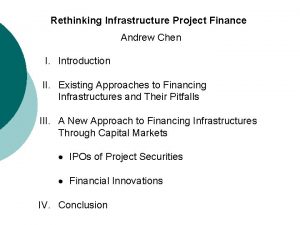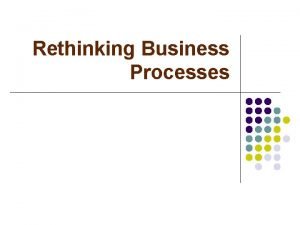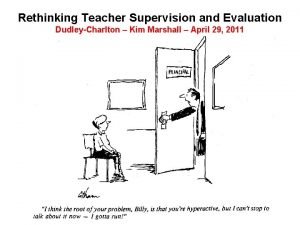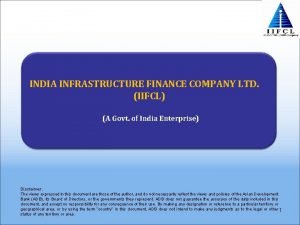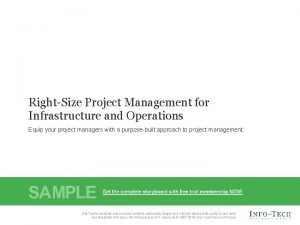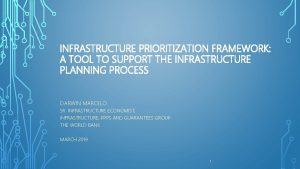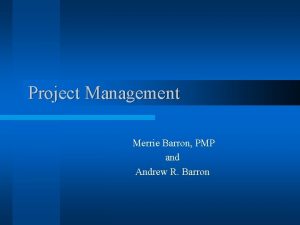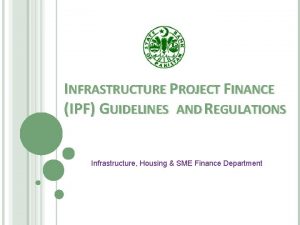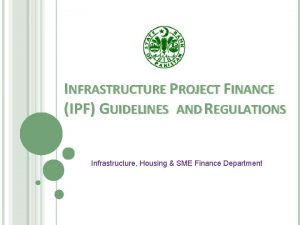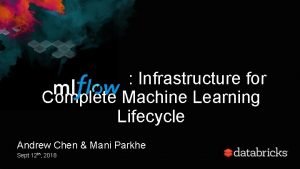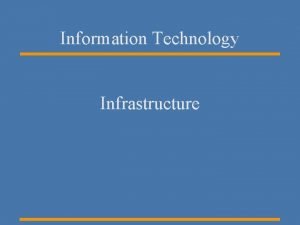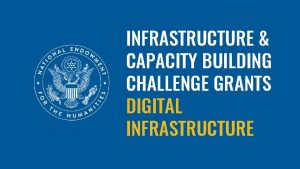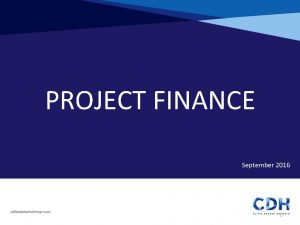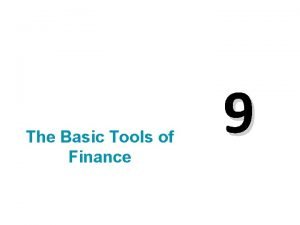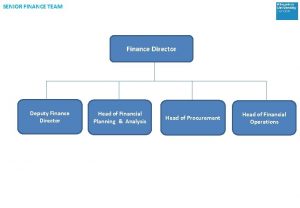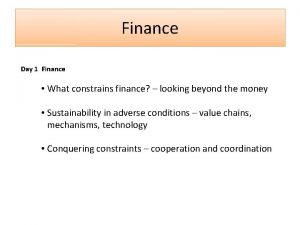Rethinking Infrastructure Project Finance Andrew Chen I Introduction






















- Slides: 22

Rethinking Infrastructure Project Finance Andrew Chen I. Introduction II. Existing Approaches to Financing Infrastructures and Their Pitfalls III. A New Approach to Financing Infrastructures Through Capital Markets IPOs of Project Securities Financial Innovations IV. Conclusion

Motivation 1. Successful development of large-scale infrastructures is vitally important for economic growth in developed and developing countries alike. 2. Huge volume and poor performance of infrastructure projects around the World. 3. The success of major infrastructures is too important for the rapid economic growth to be left to politicians, whose hands are often tainted with green. 4. Infrastructure financing should be guided by the capital markets’ invisible hand. And a key part of such financing must come from financial innovation. 5. Are M&M Propositions invalid in project finance as Esty (2004 a) has claimed?

Huge Volume Project-financed investments grew at compound annual growth rate of 20% through most of the 1990 s. It reached $165 billion in 2003. Esty (2004 a) As of May 2004, there were 240 BOT projects in East Asia and 240 in South America. Since the early 1990 s, the UK has signed over 569 PPP projects with an overall value of £ 52. 6 billion. Many more large-scale infrastructure projects with billions of dollars are being planned around the world today.

Poor Performance Examples: 1. The Eurotunnel – Total estimated cost for the project was £ 4. 9 billion in 1987, and the total actual cost was £ 9. 7 billion in 1994. 2. Boston’s CAT Project (Big Dig became Big Drip) – the total cost was $14. 6 billion, six times of the original cost estimate of $2. 6 billion. It was five years late and is now riddled with hundreds of water leaks that need to be fixed. Of 60 large engineering projects in the world with an average size of $1 billion undertaken between 1980 and 2000, 40% of them performed very badly and either abandoned totally or restructured. Miller & Lessard (2000) Of the large transport infrastructure projects, the cost overruns of 50% to 100% and revenue shortfalls of 20% to 70% were common. Flyvbjerg et al. (2003)

M&M Propositions and Project Finance Esty (2004 a) states that “Project finance, as it turns out, just happens to be a particularly interesting and effective setting in which to illustrate the simple yet critical idea that ‘structure matters’. ” He further states “… the growing use of project finance challenges the Modigliani and Miller’s (1958) ‘irrelevance’ proposition, …” I’ll argue that the current practice in forming project companies under BOT or PPP approaches creates severe agency problems that cause failures of large-scale investment projects. I’ll further argue that under the proposed approach, the M&M propositions will apply to large-scale infrastructure project finance.

Shortcomings of Existing Approaches A. The SBOO (State-Build-Own-Operate) Approach Numerous problems: 1. Bidding on infrastructure projects is often subject to bribery and corruption. 2. Complex financing structures require much negotiation and renegotiation that can cause delays or even project halts. 3. Approval of funding for state-owned projects often go through lengthy, bureaucratic processes. 4. Public ownership creates inefficiency in construction, operations and maintenance. 5. Lessons from privatization of SOEs i) La Porta and Lopez-de-Silanes (1999) – benefits of privatization from Mexico ii) Recent privatization and securitization in Hong Kong

B. The BOT and PPP Approaches The BOT (Build-Operate-Transfer) approach and the PPP (Public-Private-Partnership) approach. The basic structure is that the project companies constructs and operates the project for 25 to 35 years before it is transferred back to the government. In the PPP model, the government buys services from the project companies. Major shortcomings of BOT and PPP: 1. Inefficient bidding processes: The bidding process is not free from the influence of politicians and is often subject to bribery and corruption. Examples: a) A bribe of $14 million was offered to Mr. Estrada, the former President of Philippines, on BOT project

b) The World Bank’s mid-1999 report – Indonesia and Philippines incurred respectively $10 billion and $5 billion in bad debt. Inefficient “contract finance” – The $3. 6 billion financing for the BTC pipeline project signed in February 2004 – took more than ten years to negotiate and required 208 finance documents and 17, 000 signatures from 78 parties. 2. Imperfect project contracts: a) The Hong Kong based Hopewell Holdings’ $4 billion BOT road and rail project in Thailand b) Enron Corporation’s $2. 9 billion PPP power plan project in India c) The Supreme Court of Philippines nullified the Terminal-3 BOT project

3. Lack of Diversification and Liquidity: Project companies under BOT and PPP have concentrated equity-ownership and small number of lending banks. Thus, the benefits of risk-sharing and diversification can not be obtained. Under BOT or PPP, project companies have severe agency problems and high agency costs due to “Contract Finance. ” Thus, the BOT and PPP approaches invalidate the M&M propositions.

A New Approach through Capital Markets IPOs of project securities through capital markets provide fundamental opportunities for risk-sharing among a significant large number of private investors through diversifications. Financial innovations in security design of project securities will reduce informational asymmetry and make them more attractive to foreign private investors. Motivations for financial innovation: TRICKME The core of the new approach to financing infrastructure is the idea that the economic value of an infrastructure can and should be determined by placing financing in private investors’ hands from the start.

Key Benefits of the new approach: 1. To ensure ample funding and strong interest in and awareness of the project on a global scale 2. To ensure broad participation in domestic capital markets and create high degree of community interest 3. To foster efficiency and liquidity in the market for claims on the project’s future cash flows 4. To improve incentives and productivity and reduce the widespread problems of cost overrun and inefficiency 5. The governments in host country could be allocated some units of project securities, so true “public-private partnership” can be achieved

Issuing Project Bonds ● A large number of project bonds should be issued through IPOs. The project bonds should have tax-free status in order to attract private domestic and foreign bond-investors. ● Furthermore, different trenches and different priorities of project bonds can be offered to attract different kinds of private bond-investors. ● Project bonds with event-risk provisions

Bonds with Bearish Event-Risk Provisions ● Project bonds with bearish event-risk provisions should protect bondholders from wealth loss due to the occurrence of some designated events. These events include wars, terrorists attacks, changes in political systems, changes in world oil prices, and changes in foreign exchange rates that might cause a significant decline in the economic value of an infrastructure project and hence a drastic downgrade in the rating of project bonds. ● If a bearish event occurs, then the project bond has effectively matured and the bondholders have the right to ask the issuer or guarantors for immediate payment of the principal amount of the bond and the accrued interest.

Bonds with Bullish Event-Risk Provisions ● Project bonds with bullish event-risk provisions can provide bondholders with opportunities for wealth gains by converting debt into equity upon the occurrence of some designated event. ● If a bullish event occurs, then the holders of project bonds with bullish event-risk provisions can immediately convert the debt into shares of project stocks.

Other Implications with Event-Risk Provisions 1) With bearish event-risk provisions, managers and stockholders are less likely to engage in certain activities that might enhance equity value at the expense of bondholders. Therefore, the agency problems and costs can be reduced, and hence improve the overall efficiency of infrastructure projects. 2) The inclusion of event-risk provisions in project bonds should be a deterrent to the politicians’ attempts to make undesirable policy changes, and thus, a more stable economic growth can be expected. 3) Project bonds with event-risk provisions will make them more attractive to both domestic and foreign bond-investors because they represent a package of bonds and put/call options to the investors. Thus, the explicit costs of debt financing for infrastructures would be lower.

Financing with Project Stocks ● Due to the high degree of informational asymmetry, foreign private investors might naturally require some guarantee from the project companies or guarantors on their investments on project stocks. A. Issuing Puttable Project Stock ● One of the financial innovations created is common stock that can be “put” back to the issuer. A “puttable stock” can be used to resolve underpricing problems arising from informational asymmetry. ● Purchasers of the puttable project stock obtain the right (the put option) to redeem the shares at some pre -specified price. Thus, the downside risk due to a decline in the share price is eliminated with puttable stock.

EXAMPLE: Suppose that one billion shares of the new project stock are issued for $10 billion worth of the equity portion of the project company. If the guarantor is willing to redeem the shares at $10 per share, then the value of the puttable stock would be worth more than $10 because of its implicit put option.

B. Issuing Project Stock with CVRs ● Investors’ commonly exhibit a psychology of “fear for downside risk and greed for upside gain. ” The project stock can be combined with Contingent Value Rights (CVRs), which permit investors to reap the benefits of possible upside appreciation while maintaining downside protection. ● In the language of financial engineering, a CVR is what is known as a “bearish put spread. ” In other words, holders of a CVR own a portfolio of two options on the same underling stock, consisting of a long position in a put option at a higher strike price (target price) and a short option in a put option at a lower strike price (base price). ● CVRs can be detached from the project stock and traded separately in the markets. ● The payoff for a CVR at expiration is simply the difference between the payoff for a long put at the target price (TP) and the payoff for a short put at the base price (BP)

● Thus, we can express the payoff to a CVR as follows: CVR = Put (TP) – Put (BP) = Max [XTP – ST, 0] – Max [XBP – ST, 0] (8) EXAMPLE: Assume again that the equity portion of an infrastructure project is worth $10 billion and that 1 billion shares of project stocks are offered in the local and global capital markets at a price of $10 per share. If the base price of CVR is set at $30 per share and the target price is set at $50 per share, then at the CVR expiration date (e. g. , 3 years after the date of issue) the market value of the package will be as follows.

The Value of (Stock + CVRs) at Expiration Date Stock Price ($) Short Put @$30 Long Put @$50 Stock + CVR ($) 0 -30 +50 +20 5 -25 +45 +25 30 0 +20 +50 40 0 +10 +50 50 0 0 +50 80 0 0 +80 100 0 0 +100

Figure 2 depicts the payoffs at expiration for holding a CVR (Panel A) and holding both a CVR and stock (Panel B). Figure 2 The Payoffs of CVR and (Stock + CVR) at Expiration $ Panel A: Payoff of CVR BP = $30 TP = $50 20 0 30 $ 50 Stock Price Panel B: Payoff of (Stock + CVR) 50 20 0 30 50 Stock Price

Conclusion ● I have described some of the major problems associated with current BOT and PPP approaches to finance capital investments around the world. Such problems can be avoided – or at least significantly reduced – if the financing is undertaken with the invisible hand of the capital market. ● Under the proposed approach, the economic value of an infrastructure is given, and thus, the capital structure of the project company is “irrelevant” as what the M&M propositions would imply. ● Of course, access to well-functioning and globally linked capital markets is a prerequisite for raising capital in the fashion I have proposed. ● The developments of capital markets, legal systems, and accounting systems are themselves important infrastructure projects vital to the economic growth of a country.
 Andrew chen finance
Andrew chen finance Chen chen berlin
Chen chen berlin Chen lin finance
Chen lin finance Intro lll
Intro lll Cdio example
Cdio example Rethinking the 4 p's
Rethinking the 4 p's Rethinking expertise
Rethinking expertise Rethinking education: towards a global common good?
Rethinking education: towards a global common good? Rethinking teacher supervision and evaluation
Rethinking teacher supervision and evaluation Rethinking file mapping for persistent memory
Rethinking file mapping for persistent memory Arxiv
Arxiv Rethinking file mapping for persistent memory
Rethinking file mapping for persistent memory What is the fundamental rethinking of business processes
What is the fundamental rethinking of business processes India infrastructure finance company limited subsidiaries
India infrastructure finance company limited subsidiaries It infrastructure project management best practices
It infrastructure project management best practices Prioritization
Prioritization Gurobipy
Gurobipy Andrew r pmp
Andrew r pmp Introduction to machine learning andrew ng
Introduction to machine learning andrew ng Introduction to machine learning andrew ng
Introduction to machine learning andrew ng Andrew ng introduction to machine learning
Andrew ng introduction to machine learning Negative tail project finance
Negative tail project finance Personal finance budget project
Personal finance budget project
